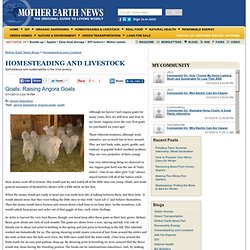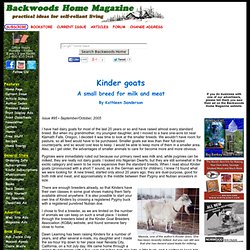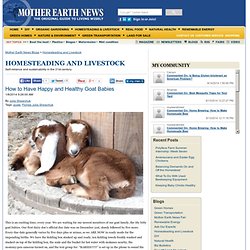

The Biology of the Goat. Cheese and Yoghurt Making. Goats: Horns or No Horns. So what gives with all the baby boys this year?

Is There Any Way to Keep the Goats Confined Without Putting in a New Fence? Goat Care Information (PDF) FAQS For Goat Owners. FAQ’s for Goat Raisers By: Leslie, The Goat Source What breed of goat should I raise?

Before deciding what breed of goat to raise, you need to decide what your reason for having goats is. If you want household milk, then a dairy breed is what you need. Keep Your Goat Warm: Try A Goat Coat. By Jake Swearingen on September 20, 2013 Goat coats aren't just a fun rhyme.

Some goats need help retaining body heat during cold winter months. Enter the goat coat. Seven years ago, Diana Niver, now 60, was running an animal rescue farm in central New York and wanted a way to keep her rescue goats warm. But there wasn’t much available on the market to suit her needs. ‘The older farmers, they don’t put clothes on their livestock. The Cost To Raise Dairy Goats. There's been a lot of interest in the dairy goat industry over the past year.

I get many calls asking about dairy goats: how much land it takes to raise them, what to feed them, and how to manage them. The one question I get asked very rarely is: how much does it cost? There is a difference between costs on a hobby operation (10 does) and a commercial operation (100 does). The scenario for this article represents a hobby operation with 10 milking does. The total cost per doe per year is $1,024. Let's look at possible income sources for a 10-goat dairy operation. Animal sales. Cost Of Raising A Goat. Irvine Mesa Charros 4-H Club Irvine, California Cost of raising a goat Here are the approximate costs of items needed for raising a goat in Southern California.

Costs will vary and are usually much less in more rural areas. Cost Of Raising A Goat. Goats & More Goats: The Goat Pages. Goat Breeds. Goats: Raising Angora Goats - Caprine Community. Although we haven’t had Angora goats for many years, they are still near and dear to my heart.

Angoras were the very first goats we purchased 24 years ago! Goats: Raising Angora Goats - Caprine Community. Kinder Goats: A Small Breed For Milk & Meat. I have had dairy goats for most of the last 20 years or so and have raised almost every standard breed.

But when my grandmother, my youngest daughter, and I moved to a bare one-acre lot near Klamath Falls, Oregon, I decided it was time to look at the smaller breeds. We wouldn't have room for pasture, so all feed would have to be purchased. Smaller goats eat less than their full-sized counterparts, and so would cost less to keep. I would be able to keep more of them in a smaller area. Also, as I get older, the advantages of smaller animals to care for become more and more obvious.
Kid (Baby Goat) Care & Information. Kid (Baby Goat) Care & Information. How To Tell If A Goat Is Pregnant. How to Have Happy & Healthy Goat Babies. This is an exciting time, every year.

We are waiting for our newest members of our goat family, the itty bitty goat babies. Our first dairy doe’s official due date was on December 31st, closely followed by five more. Every due date generally varies by five days plus or minus, so we ARE NOW in ready mode for the impending births. We have the kidding box stocked up and ready, ten kidding towels freshly washed and stacked on top of the kidding box, the scale and the bucket for hot water with molasses nearby, the mommy-pen cameras turned on, and the text group for: “BABIES!!!!!!”
Is set up in the phone to sound the “alarm” to the interns when the time comes. The Signs The Birth The average birth goes like this: it is cold and rainy out and night. The Preparation The secret to happy and healthy birthing is no secret at all, just good organization, a well-stocked kidding box and of course, a bit of luck. Sharing. How to Have Happy & Healthy Goat Babies. 10 Goat Milking Barn Plans Section 2 (PDF) 10 Goat Milking Barn Plans Section 1 (PDF) Goat Care Information (PDF) Edible & Poisonous Plants For Goats. People have asked me to share a listing of edible & poisonous plants for goats, but I hesitated to make a list of plants you can, or shouldn't feed, to goats because there is no possible way I, as one person, could know all plants the are poisonous to goats.

I may know most in my own area (East TN, USA), but there may be plants in places such as CA, England and Australia that I do not know, may would mistakenly not add to the list. I do not want the responsibly of a goat getting poisoned because I did not list the plant the goat was fed. How Much Pasture For A Sheep Or Goat. In multi-species grazing, with cows, goats, and sheep in the same pasture or paddock together, it can be seen that the cattle prefer the grass, sheep the forbs (broad-leafed herbs), and goats the browse (woody herbs and shrubs).

Each species does eat of all three categories, but the animals select their respective plants first, moving to other plants later. My research has focused on miniature dairy goats on intensively managemed pasture (attempting a zero grain, low hay diet). I live in subtropical Florida, so we have green grass all year round. Though my interest is in goats, the bulk of information available is on cattle, so most of my collected knowledge relates to grass rather than browse (and forbs least of all). My research has shown that, intensively managed, my 0.6-ac backyard with low natural fertility will be sufficient for a herd of between 6 and 8 goats (average weight of each miniture goat is 75-lbs). Feeding Goats Cheaply. Keeping Feed Cost Down For Goats (Feeding goats cheaply) This program works well for open breeding age does and mature bucks. As with any feeding program gradually change their diet. Gardern Produce- Sunflower seeds( the seeds are high in protein and the goats will eat the entire plant), mangel beets, Jerusalem artichokes, pumpkins, comfrey, carrots, kale, turnips, corn husk and corn stalks- all high protein easy to grow and the goats love them.
If the farm plants corn next to our farm, we gather all the corn husks and stalks after they pick the field, and put them in our feeders. Good Production Practice # 3 Injection Site Management. Good Production Practice # 3 Injection Site Management For many medicines and vaccines, injection is the only method of administration. Although the purpose of an injection is to benefit your animal, each injection has the potential to do harm. The harm may be pain or suffering; however, the injection could also create residues, scar tissue, or abscesses. The following are methods of giving vaccines and injection treatments to prevent problems at injection sites and to maximize the benefits of your treatments. Buy good-quality, sharp needles; Monoject is one of the best brands. Use a new, sterile, disposable needle for each animal.
Improper animal restraint is the cause of most bent needles. Injection Methods There are two primary methods for giving injections. Giving Goat Injections. If you own goats, then you’ll need to learn to give them shots. Goats need a CD/T (and BO-SE in some areas) shot annually and most antibiotics have to be administered via injection (it’s generally not economical to have a Veterinary do it), so it’s a skill goat owners have to learn. There are three main types of injections given – the medication label or the Veterinary should indicate one of the three methods below (if both IM and SQ are given as acceptable methods, it’s generally given to goats SQ): Intramuscular (IM): Given deep into the muscle.
Generally a needle length of 1” to 1 ½” and gauge of 18 to 20 is used (the larger the gauge, the finer the needle). Goat Injections - eXtension. Administration of injectable medications is sometimes necessary in the routine management of goat herds. The following recommendations are guidelines for proper administration technique for each type of injection. Following these guidelines and using proper equipment and animal-handling methods will reduce stress on animals during treatment. Practicing proper sanitation will minimize introduction of bacteria into medication vials and/or the patient, thereby reducing injection reactions and abscesses.
Dirty needles and syringes spread disease if used on multiple animals, so the use of dirty equipment should be avoided. How to Give Your Goat an Injection. You can have a vet visit or take your goats to a clinic to receive vaccinations or other injections, and many goat owners do this. But to save the money, you can do it yourself. Giving injections is easy after you get over any fear you might have. It can help to have an experienced person demonstrate the technique before you try it. Fias Co Farm/Goats- Vaccination, Worming & Health Care Schedule. Goat Vaccination Program - eXtension. Vaccination protocols should be minimally aimed toward the prevention of diseases in your herd and should be developed in consultation with your local veterinarian. Recommended Vaccination The vaccine commonly known as “CDT” or “CD&T” is a vaccination for Clostridium perfringens type C + D and tetanus. This is the vaccine that everyone raising goats should use. The label directions should be followed closely, including those for handling and storage.
Several companies make CDT vaccines and some of those include vaccines for additional clostridial diseases. Does should be vaccinated for CDT approximately 30 days prior to giving birth to provide protection to the kids through the first milk, or colostrum. Kids should be vaccinated at 5 to 6 weeks of age and then given a booster three to four weeks later. Breeding bucks, yearlings and other adults should get annual boosters 30 days prior to the breeding season or when others in the herd are given booster vaccines. National Pygmy Goat Association. Common Vaccinations for Goats. PYGMY, NIGERIAN, & and PYGORA MINI GOATS for Sale - MINI GOAT CARE AND FEEDING. Nigerian Dwarf Goats and the Pygmy Goat. Pygmy or Dwarf Goat? Although both Nigerian Dwarfs and African Pygmies are both of West African origin, they are two separate and distinct breeds.
It can be easy to confuse the Nigerian with the Pygmy because of the similarities of size and origin, but the similarities stop there.